Menu
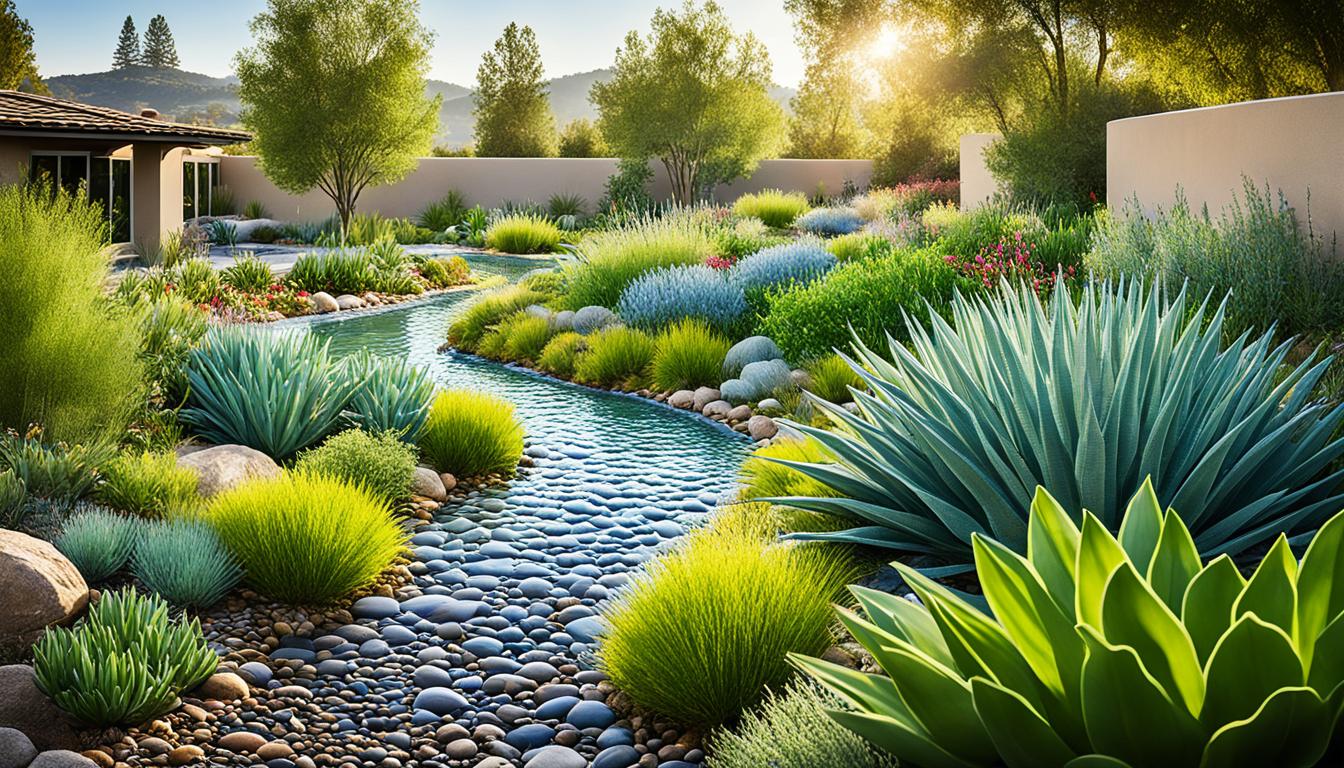
Do you know that about 10 trillion gallons of stormwater runoff goes into U.S. waters every year? Most of this water comes from cities. It shows we need to act fast to use water wisely and make sure we keep our planet environmentally sustainable. Places like streets and rooftops let out more water than forests. This makes it really important to manage water better and focus on green water management.
When our cities grow, old-fashioned systems for handling rainwater don’t work so well. They cost a lot and aren’t as good as newer green solutions. By using more green technology, we can stop pollution and save water for the future. It’s time we change the way we manage water and start doing things that help our planet.
Only 3% of the Earth’s water is freshwater. Less than a third of that is available for farming and city use. This shows why we must use water sustainability strategies. Our freshwater sources around the world are facing big challenges. More than 2 billion people depend heavily on aquifers. And many of these are being used too much.
Because usage is increasing, more than half the world’s biggest aquifers are drying up. Projections say we might have 40% less freshwater for important needs if nothing changes soon. That’s why we must start using water more carefully right now. The problem is made worse by the changing climate. It makes water scarce and affects its quality. So, water conservation is key.
Farming uses up to 70% of our yearly freshwater. It’s an area where applying better water use methods can really help. Things like smarter irrigation and managing crops better are already making a difference. But, big cities are facing water shortage problems too. Around 1 in 4 big cities has challenges getting enough water. Cities like Lima and Bogota show us this problem.
The following table highlights some crucial statistics reflecting the current global water crisis:
| Statistic | Value |
|---|---|
| Global Freshwater Percentage | 3% |
| Dependence on Aquifers | 2+ billion people |
| Expected Drop in Freshwater Reserves | 40% |
| Annual Water Consumption by Agriculture | 70% |
| Water-Stressed Cities | 1 in 4 |
| Second Largest Desert City | Lima |
The United Nations is urging for more water and sanitation. This campaign shows why water conservation is so key. It says everyone must act. Doing so can help the economy and prevent fights over water. In the end, it makes communities stronger and healthier.
It’s clear that good water sustainability strategies are vital. These help keep our natural world safe and our societies healthy. If we use water wisely, we can overcome the challenges of the global water crisis. This way, we ensure a sustainable future for those who come after us.
Cities today face important choices in stormwater management. They can go the green route or choose grey methods. By understanding these options, we can plan cities that are both modern and eco-friendly.
Green infrastructure is all about using nature to deal with stormwater. It includes things like capturing rain or filtering water through plants. This approach is seen in cities like Calgary and Edmonton. It uses the power of nature to keep our water clean.
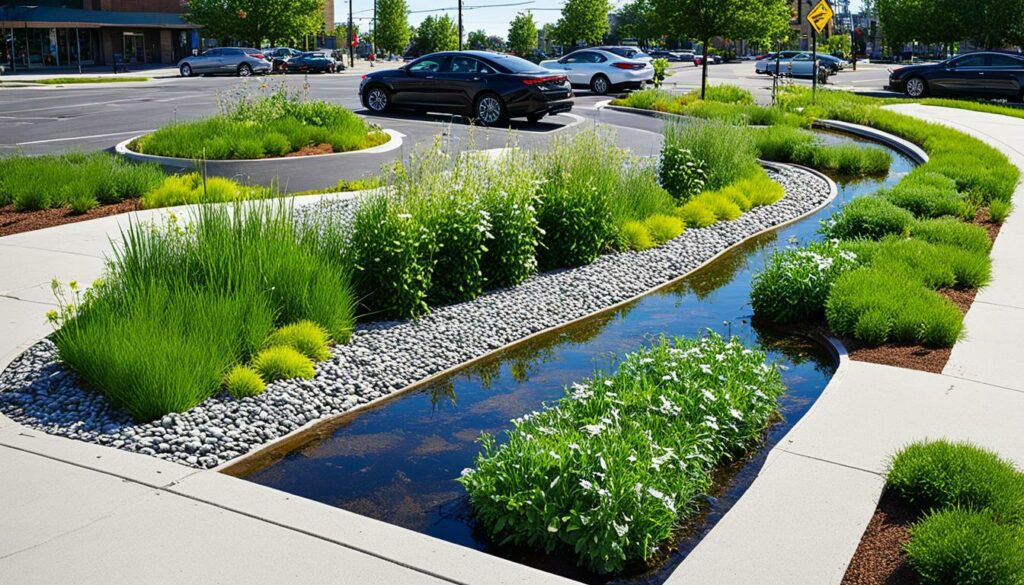
On the other hand, grey infrastructure uses man-made systems to handle water. Think of storm drains and treatment plants. While it’s efficient, it can be costly to build and maintain. This is especially true as cities grow and change.
Green methods do a lot more than just help the environment. They make cities cooler and more pleasant for people. By using green spaces to control water, we can also tackle social issues and save money.
New York and Philadelphia have shown how green projects can be a win for everyone. They saved a lot of cash while improving their cities. Also, people tend to like and support projects that are easy on the planet.
Using both green and grey methods can be the best answer. It combines nature’s power with the reliability of man-made systems. This mix helps cities handle their water wisely.
| Aspect | Green Infrastructure | Grey Infrastructure |
|---|---|---|
| Examples in Alberta | Rainwater harvesting, constructed wetlands, green roofs | Gold Bar Wastewater Treatment Plant, Springbank Off-Stream Reservoir, flood mitigation berms |
| Benefits | Environmental improvement, social equity, cost savings, community cohesion | Defined asset life, predictable ROI, effective stormwater management |
| Challenges | Measuring ROI, risk management, regulatory uncertainties | Funding, public investment, maintenance, urbanization impacts |
Effective water conservation is key in tackling the global water scarcity issue. We can lessen the problem by changing how we behave and using new technology. This way, we all help the planet better.
Changing our behaviour is critical in saving water. Little changes in our daily habits can go a long way. For example, many families waste a lot of water through leaks. Just by fixing these leaks, we could save thousands of gallons every year.
Using plants that grow naturally in our area can also use less water. These plants are used to the local weather and do not need as much water. This not only saves water but helps the environment too.
Keeping hot water pipes warm by insulating them also saves water. It means we don’t have to wait as long for hot water. Using water-saving tools and machines in our homes can cut our water use by about 20%. These are all easy ways to save water in our daily lives.
New technology provides great ways to save water. For example, Smart Irrigation Systems water plants exactly as much as they need. This stops plants from getting too much water, which can often happen. It’s great for farms and gardens.
There are also tools that can tell us if there’s a leak in our pipes. Finding leaks early can save a lot of water and prevent damage. Also, there are new ways to clean and reuse wastewater. This can help us deal with not having enough fresh water.
Systems that collect rainwater are another smart way to avoid using too much city water. They gather water from rain for us to use later. Thanks to these technologies, we can be more water-efficient and look after water better worldwide.
Combining these ideas with new technology can really make a dent in the global water conservation effort. So, let’s all start making a difference today.
Water is vital, but only 3% of water on Earth is fresh. We must manage water wisely. Rainwater harvesting and greywater recycling are effective and eco-friendly.
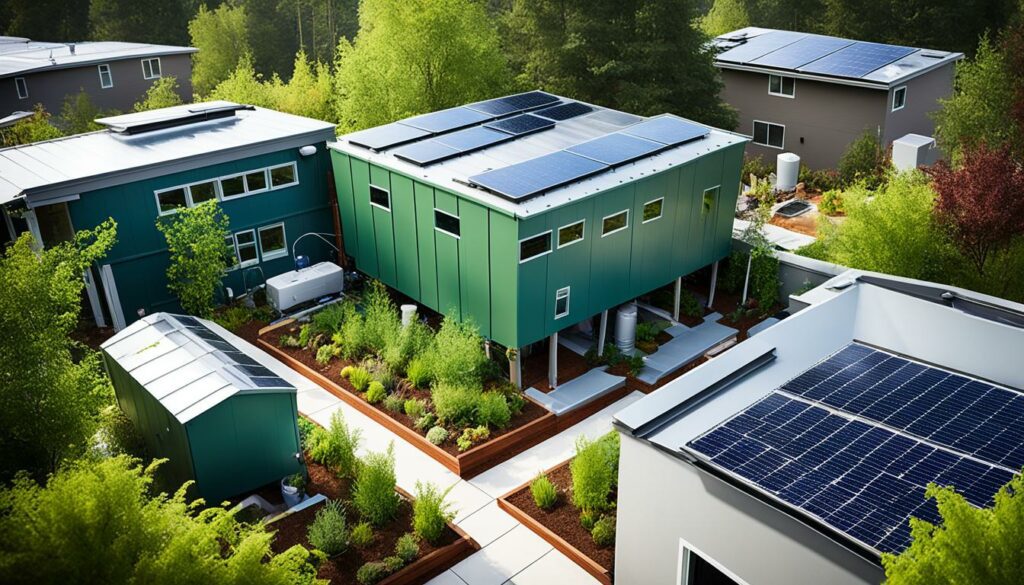
Gathering and storing rainwater for later is rainwater harvesting. It cuts our need for city water and offers a backup when it’s dry. Using rain barrels and cisterns can save money and the environment.
A rain barrel can catch up to 50 gallons from 1 inch of rain. This water can be used for many things, like watering plants or flushing toilets. This way, we save drinking water.
Greywater recycling is about reusing water from baths, sinks, and washing machines. It saves fresh water and lessens the water we send to rivers and seas. Just running a dishwasher uses up to 15 gallons of water. Reusing this water can save a lot.
Greywater goes through filters to clean it for reuse. It can then be used for crops, flushing toilets, or washing cars. This helps save on clean water and its transport and treatment.
By using rainwater and recycling greywater, we lighten the load on city water. This leads to a more sustainable water future.
“Currently, more than 80% of the wastewater produced globally is discharged back into rivers and seas without any treatment.”
| Methods | Uses | Benefits |
|---|---|---|
| Rainwater Harvesting |
|
|
| Greywater Recycling |
|
|
Adopting strong green water management is key to fair water sharing and keeping our water life healthy. There are two top methods in this field: Integrated Water Resource Management (IWRM) and watershed management.
IWRM is all about working together and seeing the big picture to meet water needs. It brings different groups together to wisely use water, land, and more, benefiting society while protecting nature. With heavy rains happening more often, IWRM is becoming increasingly important.
Things like catching rain, cleaning dirty water, and reusing greywater are big players. They can help tackle issues from big floods to keeping water clean for the future.
Watershed management keeps a close eye on how we use land and water in a certain area. It makes sure we have enough clean water and that dirty water doesn’t harm our environment. By working together, we can fight problems like polluted rainwater.
This way of managing areas could stop 10 trillion gallons of dirty water from reaching the U.S. waters each year. Plus, using practices like green roofing can catch most of the rain, reducing the need for water to flow off quickly and helping further by refilling underground sources.
These smart steps don’t just help avoid floods. They make sure everyone gets their fair share of water. By 2100, these efforts could save up to $750 million a year in flood damages. This is why it’s so important to use these caring methods in both cities and countryside.
It’s vital for all of us, whether as individuals, in governments, or within organisations, to use water wisely. If we all adopt sustainable water practices, we help save this vital resource for our children’s children.
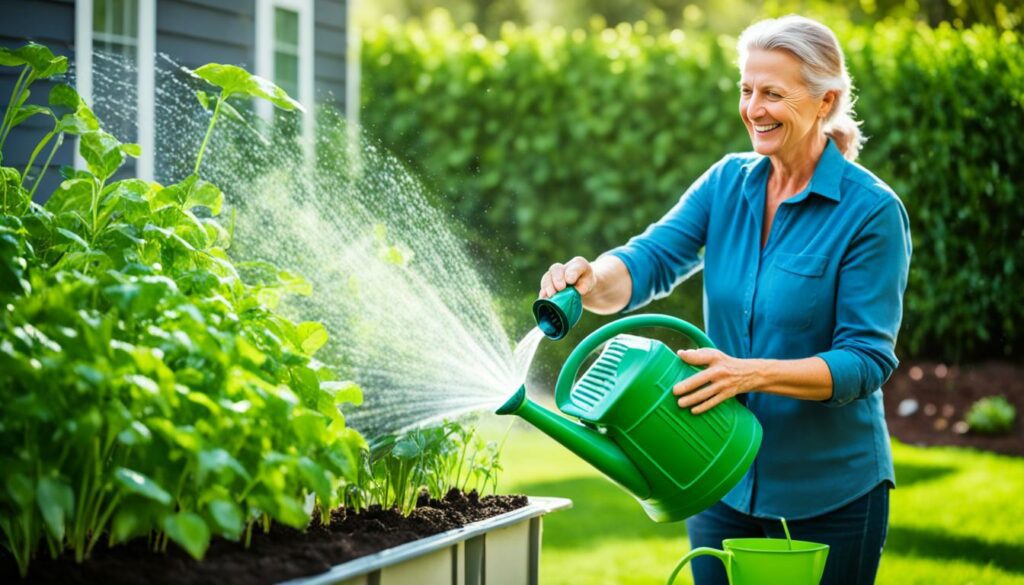
People’s efforts in using water wisely really count. Doing things like waiting to run the dishwasher until it’s full can save a lot of water. Compared to old models, front-loader washing machines save much more water. They use about 7 gallons, while older machines can use up to 40. Using low-flow showerheads and ULF toilets also helps save water.
Both governments and organisations have the power to make big changes. They can set rules and make big projects that protect water. For example, the Water Foundation made a tool in 2012 to check how well areas manage their water. The Sonoma County Water Agency and IEUA did well using this tool, with IEUA getting a gold rating in 2016. They were good at managing water while facing challenges.
To help save water, governments can make new rules. They could give money to help buy water-saving things. And organisations can also help by checking how much water they use. They could also use practices like collecting rainwater to water plants. These things can make a big difference.
By rewarding the best efforts with awards and getting everyone involved, we can make sure water is used wisely. This way, using water responsibly becomes a key part of our future.
| Organisation | Year | Initiative | Outcome |
|---|---|---|---|
| Water Foundation | 2012 | Commencement of Sustainable Water Management (SWM) Profile | Development of assessment tool |
| Sonoma County Water Agency | 2014 | Pilot project for SWM Profile | Initial testing and enhancement |
| Inland Empire Utilities Agency | 2016 | Second pilot project | Gold rating for water stress management |
| Water Foundation | 2019 | Publication of SWM Profile paper | Summary and lessons learned |
Using water wisely is key to making sure it’s available for our kids and their kids. Techniques like reusing water and topping up underground water sources help keep our taps flowing. They also help tackle problems caused by more people and climate change.
Reusing water means turning waste water into usable water for things like watering fields, making goods, and even for drinking. It saves the fresh water we have and lessens the harm of throwing away dirty water.
The SWM Profile helps water groups use water smarter, giving them scores from no rating to gold. In 2016, the Inland Empire Utilities Agency got a gold for leading the way in reusing water.
Storing water in underground areas through aquifer recharge is as important. It helps keep the ground water supply full in places that don’t get a lot of rain.
The SWM Profile also checks how well we’re putting water back into the ground. Working with banks, governments, and NGOs, groups like the Pacific Institute show us how to do this right, using their tips and tools.
Thanks to these methods, our water future looks brighter. Reuse and recharge are key to keeping our water safe and plenty for tomorrow’s people.
Eco-conscious water initiatives are key to a greener world. They use new ideas in local and global projects. These make a big difference in saving water worldwide. Let’s look at what these plans do for our area and the planet.
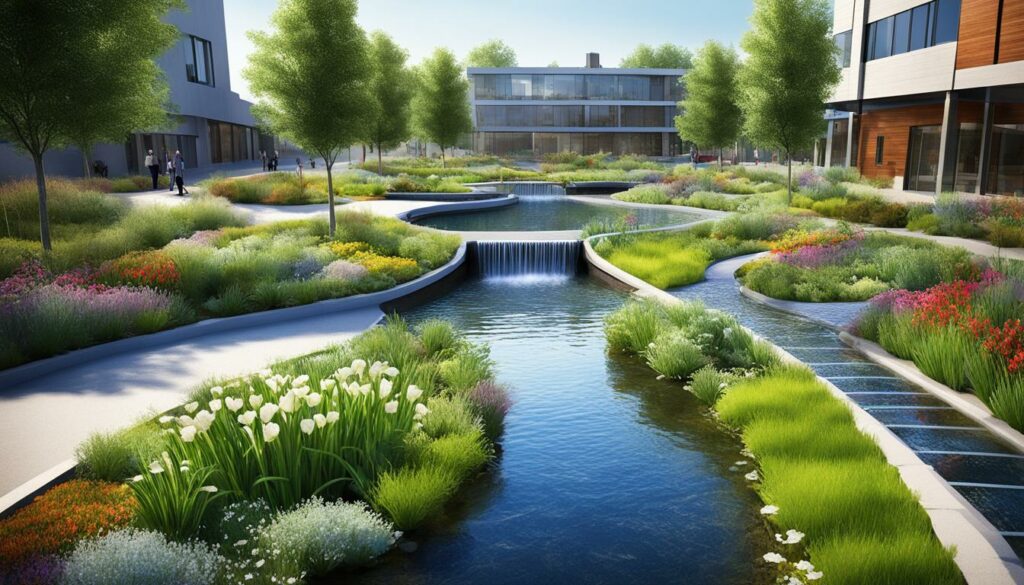
Local projects are the heart of green water works. They give people and teams the chance to save water directly. Here are a few examples:
These local projects help build a community that values saving water. They show how important it is to use water wisely.
Worldwide, many projects are working towards saving water. They show the planet’s strong will to manage water well. Here are some big steps in the green direction:
These efforts show the different ways the world is tackling the water problem. They stand united against the scarcity of water.
| Initiative | Organisation/Company | Outcome |
|---|---|---|
| rPET Usage Increase | BlueTriton | 20% usage by December 2020 |
| Carbon Neutrality | Primo Water North America | Achieved in October 2020 |
| Recyclable Packaging | Danone | 50% global sales B Corp certified |
Local and global projects combine many ways to care for water. They spark a lasting commitment to saving water. Plus, they prove that simple acts can make a big difference for the environment.
The link between climate change and our water is clear worldwide. The Earth heating up messes with the water cycle. This causes big changes in how much water we have and its quality. Let’s look into these effects and the actions needed to keep our water use sustainable.
Climate change is making freshwater scarcer. Only a tiny amount of water, 0.5%, is fresh and usable. This problem is worse as we’re losing stored water on land slowly. Places like the U.S. Southwest will likely see worse and longer droughts. Changing rain patterns are making some areas wetter and others dryer, affecting our ability to support life and grow food.
By 2050, over 1.6 billion people could face flood risks, up from 1.2 billion now. About a quarter of the world had low water supply risk in the past decade because of a lack of water. We must now do much more to stop these problems. We need to cut the pledges we make about climate action from now until 2030 by four times to stop too much warming. If we want to keep the Earth from warming too much, we need to cut these promises by seven times instead.
Climate change also hits water quality, making flooding and pollution more common. Places like the U.S. northeast are getting hit more by heavy rains and snows, spreading contaminants. These events also make it easier for harmful algae to grow and for pollutants to build up in our water. This harms sea life and the fishing industry.
Using nature for solutions, like green areas that soak up bad water, can help. So can using technology like computer models and tools that let everyone have a say in the plan. We must take big steps to handle our water better in our ever-changing world. This will keep our water clean and enough for everyone to use.
Getting urban water sustainability right means we must use new ideas. Things like promoting green infrastructure and smart urban planning help a lot. They make our cities ready for water challenges and make city life better.
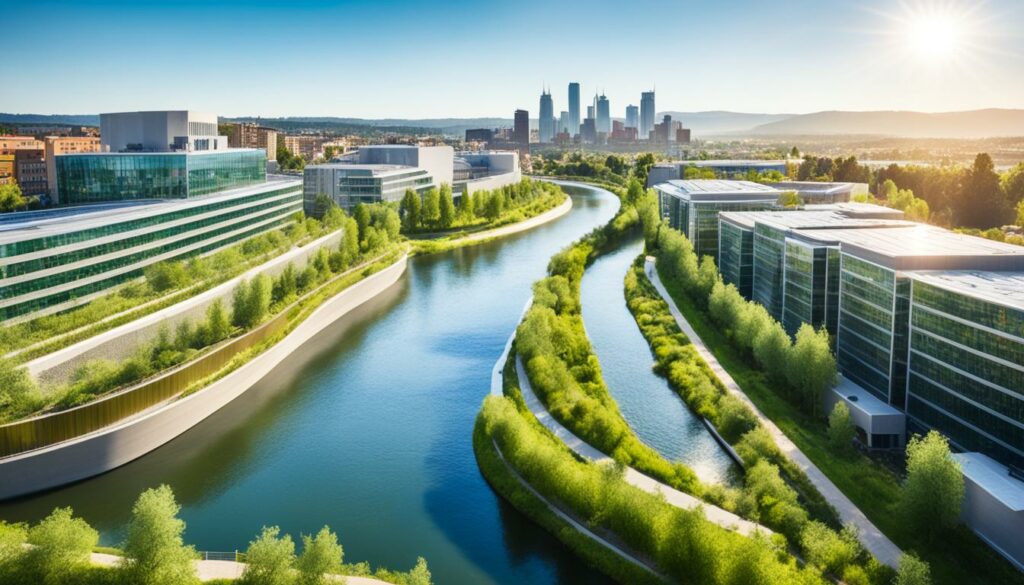
Green infrastructure can catch a lot of rainwater. It keeps water that falls on roofs for use in gardening and more. This is very needed in cities. Here, most of the rain runs off, causing problems. For instance, in the U.S., the EPA says this runoff dumps 10 trillion gallons of dirty water into waterways each year. Helping to stop this, green infrastructure not only prevents pollution. It also lowers flood risks, maybe making flood areas smaller in the future.
Using smart urban planning can help fix the water issues in growing cities. Places like Copenhagen and Singapore are good models for this. In Copenhagen, smart water networks and a sharp eye on leaks mean they lose very little water. Singapore, with special technology, uses water super wisely. This has made them able to meet over 60% of their own water needs.
| City | Key Achievements | Strategies Implemented |
|---|---|---|
| Copenhagen | Water loss rate | Efficient distribution networks, leak detection |
| Singapore | Water self-sufficiency > 60% | Smart technologies, real-time monitoring |
| Melbourne | Potable water use decreased over 40% | Rainwater harvesting, recycled water |
| Stockholm | 99% wastewater purification | Advanced purification processes |
Using green ways and smart plans is key to the water future of our cities. Looking at what cities like Copenhagen, Singapore, Melbourne, and Stockholm are doing can guide us. They show us how to create cities that handle water well and are good for the planet.
Using water wisely in farming is crucial for our planet. Agriculture uses 80% of America’s water. So, it’s very important to use water better and protect the soil. Drip irrigation and mulching are two great ways to save water and care for the soil. They are key for a sustainable future.
Drip irrigation is a smart and green way to water plants. It sends water straight to plant roots using a network of pumps, tubes, and small holes. This saves a lot of water. Studies found it can use 30-70% less water than old methods. It even works better when powered by the sun. These solar drip systems are backed by the United Nations for their environmental benefits. They are helping farmers save water and move towards sustainability.
Drip irrigation does more than just save water. It helps plants use water better, leading to healthier growth and more produce. This is especially important in dry areas. Thanks to support from various projects offering solar and mechanical pumps, many farmers globally are switching to drip irrigation. They are finding better ways to grow their crops while using water wisely.
Mulching is key in green farming. It involves covering soil with organic or inorganic materials. This keeps the soil moist, maintains its temperature, and lowers erosion. Mulching is directly liked to healthier soil. It improves soil’s structure, lets water soak in better, and adds to its organic matter. This way, it not only saves water by stopping it from evaporating, but it also helps crops grow in a better environment.
Mulching has lots of advantages. It helps controls weeds, meaning less need for harmful chemicals. It also makes the soil better for growing over time. Together, these make mulching a must-do for sustainable farming. It keeps the soil healthy and uses water in the best way.
By using drip systems and mulching, farmers can make big changes in how they use water. These techniques are not only good for the environment but also keep the soil in top shape. They are essential for farmers who want to protect the earth and grow food in a smart way.
Technology is key in our fight for a greener planet, specifically in managing water. Each person uses 20-50 litres of water daily. Making the most of each drop is crucial. Smart irrigation and water monitoring tech are changing how we look at water use. They help us use water better, ensuring we save it for the future.
The world’s need for water is growing fast, especially in farming. Smart irrigation is changing the game by using data to water plants exactly when they need it. This not only saves water but also helps crops grow better. By 2050, we’ll pull out 15% more water, showing how urgent it is to use tech for water wisely.
Tech that watches water quality and use is vital for saving water. These tools help find leaks and use water smarter. By adding aerators to taps, we can cut water use by 9 litres per minute. That’s a big saving each month. Also, solar-powered desalination plants in Namibia and Kenya show how we can get more water, even in dry places.
LifeStraw is a great example of tech that makes clean water easy to get. It can clean 4,000 litres of water. There’s also fog capture tech, which makes hundreds of litres of water every day. Add rainwater harvesting, and we have new ways to secure water for the future.
Using these new tools not only saves water but also secures a better water future for everyone. For more about tech saving water, visit here.
Sustainable water practices are ways of handling and preserving our water. They make sure there’s enough water for those who come after us. These methods help save the environment, use water wisely, and keep natural habitats safe.
With more people needing water and the effects of climate change, there’s a big demand to save water. These practices help save the planet, treat everyone fairly, and save money too.
Green infrastructure uses nature to manage water, like plants, and soil. Grey infrastructure is man-made, like pipes. Green solutions are better for the planet and are cheaper over time.
Simple changes like fixing leaks and using water-efficient devices help a lot. These tips, alongside technology, cut down on water use. They’re great for the planet too.
By collecting rainwater, we rely less on city supplies. This method saves water, lessens pollution, and offers water for things that don’t need drinking water.
IWRM is a full picture approach to using and protecting water. It joins the dots between people’s needs and nature. It’s about meeting these needs without harming our planet.
People can save water by fixing leaks and using smart devices. Knowing how to use water wisely and joining with others make a big difference too.
Wastewater reuse saves fresh water and avoids pollution. Aquifer recharge boosts our underground water, making water more secure and sustainable.
These efforts include local projects and global goals like the UN’s. They teach, find new solutions, and work together to keep water sustainable.
Climate change messes with the way we have water. It makes droughts and floods worse and can ruin water quality. We need new ways to prepare our water systems for these changes.
Cities are using green ways to manage rainwater and thinking ahead with new rules and urban designs. They also rely on smart technology to use water better. These steps make cities stronger against water problems and help them grow in a way that’s good for the earth.
Using drip systems and keeping the soil covered with mulch are great for saving water in farming. These methods use water wisely and help farming to last for a long time.
New tech makes it easier to use water smartly, from keeping our gardens green without waste to watching how we use water at home. These tools let us bring out the best in how we manage water.